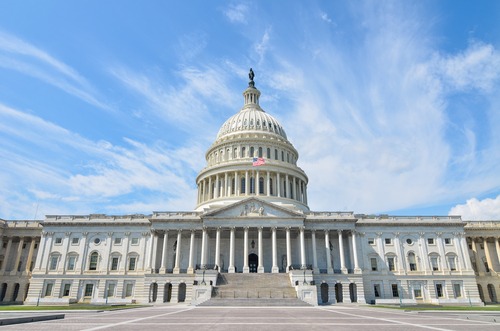Power industry stakeholders applaud House passage of Build Back Better Act

Numerous power industry organizations commended Friday’s passage of the $1.75 trillion Build Back Better Act by the U.S. House of Representatives, which advanced the measure to the Senate for consideration.
“The bill’s clean energy tax incentives will benefit electricity customers, create jobs, provide long-term certainty to our industry, and create a level playing field that recognizes the role of electric companies in deploying more clean energy.” said Tom Kuhn, president of the Edison Electric Institute (EEI), which represents all of America’s investor-owned utilities (IOUs).
Specifically, H.R. 5376 proposes numerous investments in clean energy and combating climate change, according to the White House framework for the bill, such as $320 billion in clean energy expanded tax credits over 10 years for utility-scale and residential clean energy, transmission and storage, clean passenger and commercial vehicles, and clean energy manufacturing.
EEI’s Kuhn pointed out that while pleased the House-approved bill includes a robust clean energy tax package, the organization continues to have “significant concerns” with the inclusion of a 15 percent corporate minimum tax on book income.
“Such a provision will negatively impact the capital investments electric companies make to provide their customers with safe, reliable, affordable, and resilient clean energy,” he said, adding that IOUs plan to make major capital investments over the next several years to achieve their clean energy and carbon reduction goals.
“It is important to our customers that these investments be made cost-effectively,” Kuhn said. “Congress should not undermine the act’s climate goals — and raise costs for electricity customers — by imposing a minimum tax on the capital that needs to be deployed to achieve them.”
The Build Back Better Act would also provide $105 billion for resilience investments and incentives to address extreme weather, legacy pollution in communities, and a Civilian Climate Corps; $110 billion in targeted incentives to spur new domestic supply chains and technologies like solar, batteries and advanced materials; $20 billion in clean energy procurement to provide incentives for government to be purchaser of next-gen technologies, including long-duration storage, small modular reactors, and clean construction materials, according to the framework.
If enacted, H.R. 5376 proposes federal funding for energy-efficiency and weatherization projects; electric vehicles and zero-emission, heavy-duty vehicles; public health infrastructure and supply chain resiliency; cybersecurity programs; small business assistance and development; and transit services and clean energy projects in low-income communities, among several others, according to the congressional record bill summary.
“Included in the bill’s more than half trillion dollars targeted toward climate action are needed energy efficiency investments that would provide funding to build and support more energy-efficient industry, government, and communities, including schools and affordable housing, with specific attention to tribal, low-income, and disadvantaged communities,” said Paula Glover, president of the Alliance to Save Energy. “These provisions will deliver immediate and tangible benefits to communities across the U.S.”
On a global scale, Glover called the legislation “a unique opportunity” to fulfill the nation’s commitment to emission reductions. “Energy efficiency measures alone can deliver half of the emission cuts required to get to net zero — which is why it’s so important to get these policies right and get them done,” she added.
With the bill now moving to the Senate, Glover said that the Alliance to Save Energy will continue work to ensure that energy efficiency investments are maximized.
“We look forward to final passage and implementation, and joining with the administration and others in delivering policies to build a more efficient, clean, affordable, and equitable energy future for everyone,” said Glover.
The measure also includes a 10-year extension of the solar Investment Tax Credit and strong support for domestic solar manufacturing, among other policies, said Abigail Ross Hopper, president and CEO of the Solar Energy Industries Association (SEIA).
“Decarbonizing the electric grid will add close to one million Americans to the solar workforce by 2035, and after months of negotiation, we are on the verge of approving policy that will take a meaningful step toward tackling the climate crisis,” Ross Hopper said earlier today. “We urge the Senate to complete its negotiations, pass the legislation and send the Build Back Better bill to President Biden for his signature.”
American Clean Power Association CEO Heather Zichal applauded House passage of the bill, also citing its job-creating investment for clean energy and provisions to combat the climate crisis.
“With tax credits for renewable generation, energy storage, transmission projects, green hydrogen, and the growing offshore wind energy sector and associated domestic manufacturing, a powerful signal is being sent to the private sector and industry,” Zichal said, noting that the bill will help spur new investment, accelerate the development of projects, and deliver over one million clean energy jobs by 2030.
“It will also help create growth opportunities for local communities and put the country on a path to achieve the goal of 100 percent carbon-free electricity by 2035 — which will require doubling the size of the electricity grid and tripling the amount of clean energy carried by it,” she said. “Every state in the nation will benefit from it.”
Gregory Wetstone, president and CEO of the American Council on Renewable Energy (ACORE), agreed that the Build Back Better Act is a critical milestone in America’s efforts to take on the climate challenge.
“The legislation finally moves the country beyond years of on-again, off-again renewable tax credits and establishes a stable, predictable and long-term clean energy tax platform that will spur critically important investment in renewable power, energy storage and advanced grid technologies,” Wetstone said. “This is America’s last best chance to take timely action to address the global climate crisis, and it is imperative we rapidly accelerate the renewable energy transition.”
